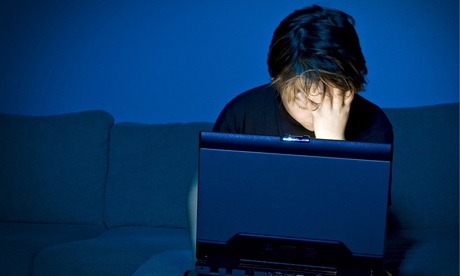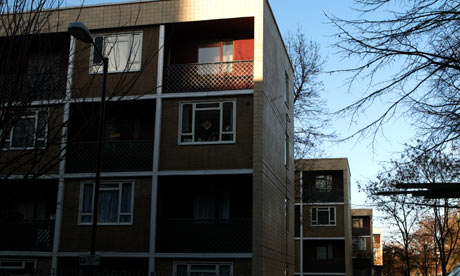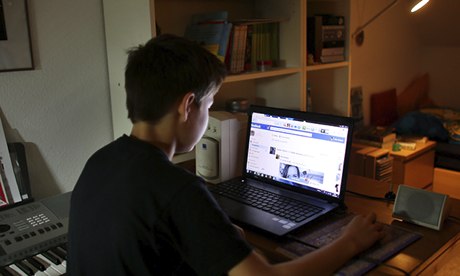"Some of the images do scare me, especially if it's my friends. Once my friend cut lines down the side of his face as a 'Chelsea Smile', he put it online and it was the worst thing I had ever seen. He's my friend, I don't want to see him that upset. He got so much hate for it and ended up going into hibernation, nobody heard from him for over a week and we honestly thought he had killed himself."
Frankie* is 15 and lives in the Midlands. For the past year or so she has updated her Tumblr blog most days. On other social networks she uses her real name, but on Tumblr – a blogging platform – she shares her darkest thoughts about depression, anxiety and self-harm anonymously. "The other day I put up a self-harm picture," she says. "I was alone and in a dark place. […] Of course, nobody would help, but posting it boosted my confidence a little; finding it buried in amongst all the other self-harm posts reminded me I'm not alone."
Fears about self-harm sites have been growing since the suicides of two teenagers who, it emerged, were obsessed with self-harm and depression blogs, with
mental health campaigners and experts warning that the UK's teens are at risk of becoming a lost generation if parents and adults cannot reach out to them across the digital divide.
Tallulah Wilson, a 15-year-old who killed herself in 2012, was caught up in a "toxic digital world", according to her mother, while the parents of
Sasha Steadman, a 16-year-old who died from a suspected drug overdose in January after looking at self-harm sites, said her "impressionable mind" had been filled "with their damning gospel of darkness".
For the uninitiated, self-harm blogs present a surreal world of fantasy and pain. Countless sites dedicated to self-harm and depression are filled with images of bleeding wounds juxtaposed with pixelated gifs, flickering eerily with snippets of Hollywood angst. Helen, who is now 18, visited them regularly, before stopping to help herself move on from self-harming. "You have people asking you how to cut yourself deep enough because their therapist said it wasn't bad enough," she says. "I have had people tell me to kill myself. I think the most traumatic is when you find someone's suicide note online and there is no way to actually get in contact with the person."
Isolated and lonely, she used the blogs because they gave her a sense of belonging. "You want to find people who are similar to you. That is what humans do," she says. "It starts off as trying to help, but then it becomes competitive and dangerous. You get sucked into this world of who can cut the deepest/be the skinniest and avoid notice by the outside world. You end up spending hours a day searching these sites for reassurance, but it just makes it harder."
Keeping
children safe online is the "child protection challenge of this generation", according to Peter Wanless, head of the NSPCC. ChildLine, part of the organisation, registered an 87% rise in calls about cyberbullying last year, a 41% increase in calls about self-harm, and a 33% increase in calls about suicide, with the biggest increase among 12- to 15-year-olds.
While the
internet provides unprecedented opportunities for young people to communicate and learn, it can be a dangerous place for vulnerable teenagers, says Sue Minto, the head of ChildLine. "Children are communicating in a way we have never seen before – all the time and instantly," she says. "Personally, I think this kind of relentless exposure is the biggest challenge we have ever faced."
Minto notes that while peer pressure and bullying have been around for a long time, the ability to be contacted at all times is new. The cloak of anonymity can lead children to make comments they would shy away from in "real" life, she says. "The pressure on children is immense and very worrying – there is no break for these young people, it is quite relentless. Children who are being bullied tell us there is no point in turning off their phone, because the messages will just be there waiting for them."
A
recent survey carried out by youth charities
ChildLine,
Selfharm.co.uk,
YouthNet and
YoungMinds revealed that 61% of the 4,000 young people who responded said they self harmed because they felt alone, while 25% cited bullying. Almost 40% said they had never spoken to anyone in the "real world" about it.
Rachel Welch, director of
Selfharm.co.uk, which supports young people affected by self-harm, says there is a huge gap between what adults see of the online world and their children's experience. "So many young people are drifting into a world where they are completely disconnected," she says.
But how dangerous are self-harm sites? Do they simply show teenage angst and creative expression, or highlight a worrying deterioration of teenage mental health?
Mary Hassell, the coroner presiding over the inquest of Tallulah Wilson, was concerned enough to write to Jeremy Hunt, the health secretary, to warn him of a risk of future deaths without a greater understanding of children's online worlds. Although Tallulah was treated by healthcare professionals, they didn't have "a good enough understanding of the evolving way that the internet is used by young people, most particularly in terms of the online life that is quite separate from the rest of life", she wrote.
A study into possible links between suicide and the internet has just been commissioned by the Department of Health and will report in two and a half years: a department spokeswoman said children's mental health was a priority for the government and pointed to the introduction of "family-friendly filters" and internet safety into the national curriculum.
But for Sarah Brennan, chief executive of the youth mental health charity Young Minds, the real issue is ignorance of the scale of the problem, or even denial that the problem exists. The current NHS commissioning of youth mental health services is based on data collected in 2004 – the year Facebook launched.
"It is shocking that the government is allowing NHS commissioners to plan services based on out of date and inaccurate data," Brennan says, adding that a Young Minds freedom of information request recently revealed that 34 out of 51 local authorities in England have reduced the budget for their children and adolescent mental health services since 2010, while a Community Care/BBC investigation this week showed that a
growing number of seriously ill children are being admitted to adult psychiatric wards or sent hundreds of miles from home for hospital care.
"We are sitting on a ticking time bomb here," says Brennan. "At the same time that we are seeing an increase in need, youth mental health services are being cut. There is an explosion of bullying online and young people struggling to cope with mental health issues, anxiety, eating disorders. If we don't do something about it we could have a lost generation."
What can be done? Since Tallulah Wilson's suicide, Tumblr has introduced a warning that pops up when users search for terms related to self-harm, directing them towards sites offering support and calling on users to report blogs with "inappropriate content" so they can be taken down. A Tumblr spokeswoman said the site was "deeply committed to protecting our users' freedom of expression", but that it draws lines "around a few categories of content we consider damaging to our community, including blogs that encourage self-harm".
And while there have been calls to shut down certain sites, such as Ask.fm – which allows users to ask anonymous questions and has been
linked to teen suicides – teenagers and professionals spoken to by the Guardian agreed that simply banning sites or "dangerous" search terms was futile. Regulation can also backfire – recent efforts to impose opt-out "objectionable content filters", backed by the prime minister, have resulted in sites such as ChildLine and Refuge
also being blocked.
"We cannot put our head in the sand, simply blame these sites or hope to regulate our way out of this," says Minto. "We are playing catch-up, but we need to take responsibility. You wouldn't let your child cross the road without talking to them about road safety and the same goes for the risks of the internet – if we don't tackle this it's like opening the door and letting them walk through this cyberworld completely unequipped."
Welch at Selfharm.co.uk agrees: "Calling for any type of ban is just missing the point. What we have to do is make sure our young people are emotionally resilient, emotionally aware and they know where to go to get help if they need it."
Others say that while parts of the internet can be dangerous for vulnerable children, it can also provide the means to keep others safe and let them talk about their problems. As many young people contact ChildLine online as call its helpline. Online friends can be a force for good.
Samantha, a 17-year-old who started self-harming when she was 14, says her Tumblr site helped her recover from depression. "I felt like I belonged somewhere, they understood me in a way I felt I had never been understood before," she says. At one point, she was off school with depression and spent all day online, answering 10-15 messages from other troubled teenagers every day. Now she "has a life" again and is online less frequently. "I've been told that I've saved lives and it made me feel good about myself that I was helping other people," she says. "It's really odd – but it works for me."
Frankie, who is still working towards recovery, has mixed emotions. While she recognises that some blogs might encourage self-harmers, or make them feel worse, she still believes they can help. "I think for [people] like myself it can be reassuring just to know there are others out there that do it too [but] what scares me is thinking how many there are, how they are all posting it online, are they all cries for help? If that many people are crying for help then something needs to be done, and fast."
*Names of young people have been changed. If you face any of theissues in this piece, you can call ChildLine on 0800 1111







